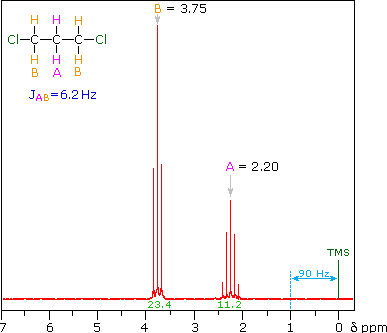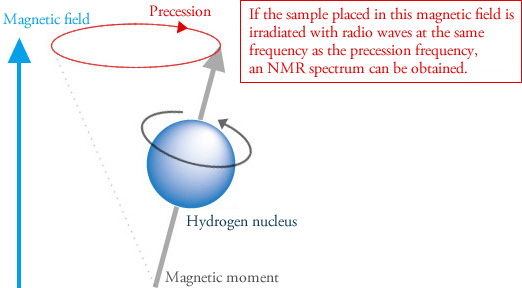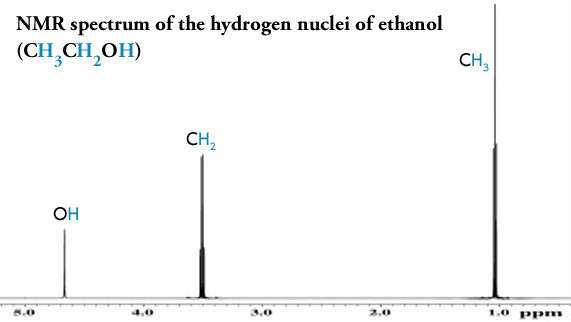Nuclear magnetic resonance NMR is a spec- troscopic technique that detects the energy ab- sorbed by changes in the nuclear spin state. 1H NMR is used to determine the type and number of H atoms.

Nmr Spectroscopy Visualized Youtube
As an introduction the history of NMR will highlight how the method evolved from physics to chemistry and finally to biology over.

. The area under an NMR resonance is proportional to the number of nuclei that give rise to that resonance. The nuclei of many elements such as 1 H spin generating a magnetic field. Nuclear magnetic resonance spectroscopy is a powerful analytical technique used to characterize organic molecules by identifying carbon-hydrogen frameworks within molecules.
This review aims at presenting in an accessible manner the requirements and limitations of this technique. Johnson Progress in Nuclear Magnetic Resonance Spectroscopy 34 1999 203256 Fig. The recent tutorial articles on PFG-NMR by Price are also of interest 1718.
In NMR spectroscopy samples are exposed to a strong magnetic field. It is administered by the College of Arts and Sciences and its equipment has been funded by grants from the National Institutes of Health the National Science Foundation the Battelle Memorial Institute and the. Nuclear Magnetic Resonance Spectroscopy or NMR Spectroscopy can be used to identify any isotope unless the isotope has both an even number of protons and an even number of neutrons.
Hornak is Professor of Chemistry and Imaging Science at the Rochester Institute of Technology where he teaches courses in magnetic resonance imaging nuclear magnetic resonance spectroscopy analytical chemistry and physical chemistry. Two common types of NMR spectroscopy are used to characterize organic structure. 2 6 integral d 36 d 12 The relative area under the resonances at d 36 and 12 is 13 The integral is superimposed over the spectrum as a stair-step line.
These moments are in nuclear magnetons which are 50507810-27 JT-1. This overview is on how solution-state nuclear magnetic resonance NMR spectroscopy has contributed to this understanding. Background Time domain NMR dates from Hahns observa-tions of.
Magnetic resonance spectroscopy MRS is an analytical tool that detects radio frequency electromagnetic signals that are produced by the atomic nuclei within molecules. The nuclei of many elements such as 13 C spin generating a magnetic field. ERNST Laboratorium für Physikalische Chemie Eidgenössische Technische Hoch-schule ETH-Zentrum 8092 Zurich Switzerland The world of the nuclear spins is a true paradise for theoretical and experimental physicists.
In certain specific circumstances MRS. The WSU Center for NMR Spectroscopy is a central University facility that provides access to state-of-the-art NMR instrumentation. 1Increased magnetic field B Tutorial - Nuclear Magnetic Resonance Spectroscopy General Concepts Nuclear Magnetic Resonance NMR Spectroscopy is a technique used to determine the type number and relative positions of certain atoms in a.
By exciting atomic spin-½ nuclei in a strong magnetic field NMR obtains information on their chemical environments. During Chemistry 222 lab you will be using NMR extensively to help assign structures to two unknown organic compounds and this tutorial and exercises will hopefully help you solve your unknown. The biomedical applications of nuclear magnetic resonance NMR are twofold.
Proton Nuclear Magnetic Resonance 1 H NMR Spectroscopy is a powerful method used in the determination of the structure of unknown organic compounds. It can be used to obtain in situ concentration measures for certain chemicals in complex samples such as the living brain. Nuclear magnetic resonance NMR spectroscopy is a versatile tool that provides information on structures and dynamics of various biological and synthetic molecules at an atomic level.
13 C Nuclear Magnetic Resonance Spectroscopy Tutorial Key Concepts. The height of each step is proportional to the area under the resonance. Nuclear magnetic resonance or NMR spectroscopy is an important method for determining the molecular structure and purity of samples in organic chemistry.
A powerful technique useful for identifying the small to the very large When some atoms are placed in a strong magnetic field their nuclei behave. Nuclear magnetic resonance NMR spectroscopy explores the electronic environment of atoms. Nuclear Magnetic Resonance Spectroscopy.
It is used to determine the molecular structure at the atomic level of a sample. The PFG-NMR experiment 31. 1 H μ 27927 19 F μ 26273 31 P μ 11305 13 C μ 07022.
Magnetic resonance imaging MRI and magnetic resonance spectroscopy MRS. NUCLEAR MAGNETIC RESONANCE FOURIER TRANSFORM SPECTROSCOPY Nobel Lecture December 9 1992 by RICHARD R. NMR spectroscopy is a powerful tool for biologists interested in the structure dynamics and interactions of biological macromolecules.
1 H Nuclear Magnetic Resonance Spectroscopy Tutorial Key Concepts. Nuclear Magnetic Resonance Spectroscopy tutorial all along with the key concepts of Basic Principle of NMR The Source of NMR Spectra NMR spectrum Pattern of the Spectrum The NMR spectrometer Operational procedure Application of NMR. Copyright 1997-2019 JP.
The following diagram gives the approximate frequencies that correspond to the spin state energy separations for each of these nuclei in an external magnetic field of 235 T. The applications of MRS as a research tool are extremely diverse encompassing studies on isolated cells body fluids and perfused organs at high magnetic field strengths in an experimental. Nuclear Magnetic Resonance NMR Spectroscopy.
He is also Director of the Magnetic Resonance Laboratory a research and. The most well-understood circadian clock at the level of molecular mechanisms is that of cyanobacteria. For the four common nuclei noted above the magnetic moments are.
The application of NMR spectroscopy to the study of proteins and nucleic acids has provided unique in- formation on the dynamics and chemical kinetics of these systems. Apart from the molecular structure NMR spectroscopy can determine phase changes conformational and configurational alterations solubility and diffusion potential Krishnan 2019. Nuclear magnetic resonance NMR spectroscopy is an advanced characterization technique.
Upon exposure certain nuclei transition or resonate between discreet energy levels. Nuclear Magnetic Resonance Spectroscopy or NMR Spectroscopy can be used to identify any isotope unless the isotope has both an even number of protons and an even number of neutrons. The simple CarrPurcell spin echo SE often called the Hahn echo.
The SCSB NMR Laboratory is located in its own two-story.

Nmr Basic Knowledge Nuclear Magnetic Resonance Spectrometer Nmr Products Jeol

Nmr Spectroscopy In Easy Way Part 1 Youtube

Nmr Spectroscopy Basic Theory Youtube

Basic Introduction To Nmr Spectroscopy Youtube

Nuclear Magnetic Resonance Nmr Youtube

Nmr Basic Knowledge Nuclear Magnetic Resonance Spectrometer Nmr Products Jeol

1 Nmr Spectroscopy Introduction To Proton Nuclear Magnetic Resonance Youtube
0 comments
Post a Comment